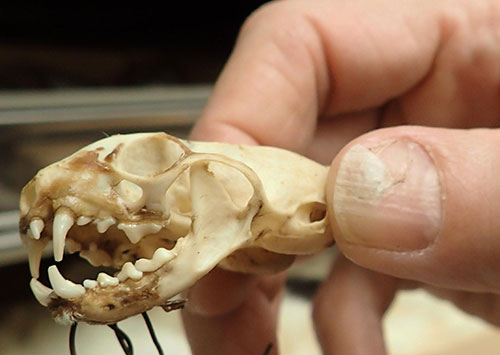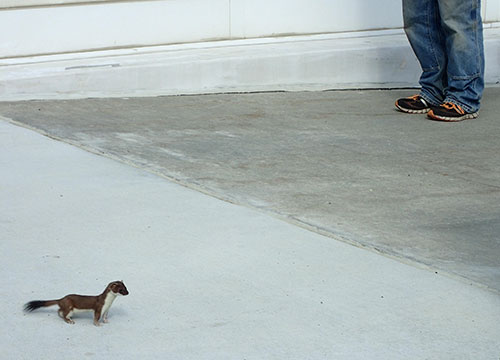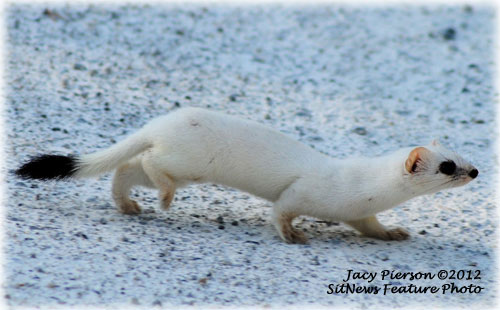
Urban ermine inspires weasel-related questionsBy NED ROZELL
October 03, 2015
We went outside and staked out the area, waiting for it to emerge from a crack between metal trim and the concrete. After a few minutes, it poked its head and torso from the 2-inch gap. Then it squeezed out, paused between us without fear and boinged past us to greenery. Since then, I have heard of several more weasel sightings. Bob, who was there at the university, saw one in his woodpile a few days later.
Link Olson holds the skull of an ermine collected from 15,000 feet on Denali.
And who is this fierce little cylinder? The one I saw was an ermine, also known as a short-tailed weasel (a stoat in Europe). There is something appealing about a weasel's sleek spunkiness that makes people want to keep one as a pet. Behind that cuteness is a killing machine. In the same family as wolverines and badgers, weasels are one of the busiest predators out there. In the basement of the museum, Olson held up the jaw of a weasel that came to the collection from 15,000 feet on Denali. He showed how the weasel's jaw, unlike ours, is designed to move only up and down. The lower jaw is locked into the skull to strengthen the force of its bite.
An ermine, or short tailed weasel, outside the Akasofu Building on the University of Alaska Fairbanks campus.
Searching for pika recently in Denali National Park, Olson saw a weasel hopping by with a vole in its mouth. He squeaked like a rodent to see if he could stop the weasel. It stopped and "appeared to be struggling to make up its mind — flee with the meal it already had or go nab another one?" Polish researchers have studied "surplus killing" in weasels, in which weasels sometimes kill more voles than they can eat and cache them in the vole tunnels they commandeer. The scientists concluded that weasels did indeed go on killing sprees. But they found weasels did it more in cold temperatures, and in extreme cold temperatures they would harvest their caches more and hunt less. They wrote that rather than a "behavioral aberration," the weasel's excess vole killing was an adaptation to life in the far north.
Southeast Alaska Ermine, or short-tailed weasel, photographed on Prince of Wales in November 2012 and a SitNews front page feature photo. While holding the ermine skull between his index finger and thumb, Olson noted how the weasel is designed to plunge into holes no larger than its head. "They can follow voles and pikas into really tight confines," he said. "But it's a trade off." The weasel's long body leaves it more vulnerable to heat loss than animals like pikas, which are almost spherical. Weasels don't hibernate, so like their relative the wolverine they are always on the move. "Weasels can't just hunker (to stay warm)," Olson said. "They have to be out hunting all the time."
|
||


